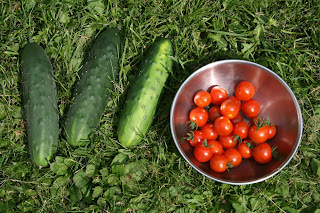Given that my
garden turned out to be Thirty Square Feet, based on the materials that I had
at hand, it seemed like a good idea to draw out a plan for the growing space
that was available. Out came the graph paper and I decided to draw the garden on
a scale of 1" = 1'. I knew that I wanted to grow a wide variety of things,
but I had no idea about how best to do that.
The traditional
way of gardening is to plant things in rows, and in fact for about ten years I
have had a small row garden in my backyard. It only measured 2½' x 22', but
over the years I have had some success with certain crops. In particular,
cherry tomatoes. There was one year where we had a steady supply of tasty
cherry tomatoes for weeks and weeks.
There was the year where the garden also produced about a dozen
cucumbers. But I was never really able to produce a succession of vegetables
such that I could say that we ate out of the garden during the summer.
I have read
various articles about gardening in small, non-traditional spaces and so I
decided to Google the phrase "square foot gardening". The best
resource that I found is an updated book published in 2006 entitled All New Square Foot Gardening
by Mel Bartholomew. Square Foot Gardening is described as the practice of
planning small but intensively planted gardens. It turns out that square foot
gardening is very popular and you will find many resources available to you on
the Internet.
There are many
advantages to this method of gardening, but there are two advantages that I
really like and will share with you. First, you can locate a square foot garden
in a relatively small space. This means that you can put your garden close to
you so that you will walk by it every day. You will pay more attention to such
a garden, and chances are it will receive better care. The second advantage is
that your garden will only take up 20% of the space of a traditional garden. This
means that you will use 80% less water and fertilizer, which is a tremendous
advantage over traditional growing methods.
So, having read
the All New Square Foot Gardening book, I decide to adapt some of those methods
to my thirty square foot space. With that in mind, I considered the kinds of
vegetables that I would like to grow and which ones might best be successful
for my garden, and worked out the following plan:
As you can see,
I am planning to get at least fourteen different crops out of my small space.
In fact, using succession planting, after the radish, spinach, and lettuce
crops have finished, I should be able to plant some other crops to maximize the
garden's yield. Gardeners are by nature optimistic and ever hopeful. I must
confess though that I will be thrilled if this garden does half as well as I am
planning!




